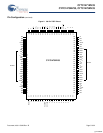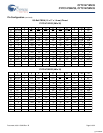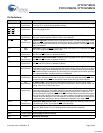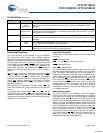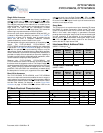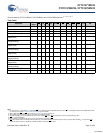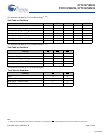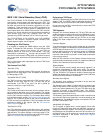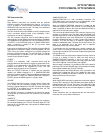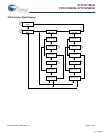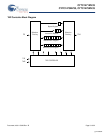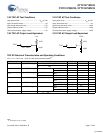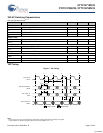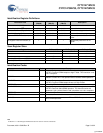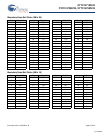
CY7C1471BV33
CY7C1473BV33, CY7C1475BV33
Document #: 001-15029 Rev. *B Page 13 of 32
IEEE 1149.1 Serial Boundary Scan (JTAG)
The CY7C1471BV33, CY7C1473BV33, and CY7C1475BV33
incorporate a serial boundary scan test access port (TAP). This
port operates in accordance with IEEE Standard 1149.1-1990
but does not have the set of functions required for full 1149.1
compliance. These functions from the IEEE specification are
excluded because their inclusion places an added delay in the
critical speed path of the SRAM. Note that the TAP controller
functions in a manner that does not conflict with the operation of
other devices using 1149.1 fully compliant TAPs. The TAP
operates using JEDEC-standard 3.3V or 2.5V IO logic levels.
The CY7C1471BV33, CY7C1473BV33, and CY7C1475BV33
contain a TAP controller, instruction register, boundary scan
register, bypass register, and ID register.
Disabling the JTAG Feature
It is possible to operate the SRAM without using the JTAG
feature. To disable the TAP controller, TCK must be tied LOW
(V
SS
) to prevent clocking of the device. TDI and TMS are
internally pulled up and may be unconnected. They may
alternately be connected to V
DD
through a pull up resistor. TDO
must be left unconnected. During power up, the device comes
up in a reset state, which does not interfere with the operation of
the device.
The 0/1 next to each state represents the value of TMS at the
rising edge of TCK.
Test Access Port (TAP)
Test Clock (TCK)
The test clock is used only with the TAP controller. All inputs are
captured on the rising edge of TCK. All outputs are driven from
the falling edge of TCK.
Test MODE SELECT (TMS)
The TMS input gives commands to the TAP controller and is
sampled on the rising edge of TCK. This ball may be left
unconnected if the TAP is not used. The ball is pulled up
internally, resulting in a logic HIGH level.
Test Data-In (TDI)
The TDI ball serially inputs information into the registers and can
be connected to the input of any of the registers. The register
between TDI and TDO is chosen by the instruction that is loaded
into the TAP instruction register. For information about loading
the instruction register, see the TAP Controller State Diagram on
page 15. TDI is internally pulled up and can be unconnected if
the TAP is unused in an application. TDI is connected to the most
significant bit (MSB) of any register. (See the TAP Controller
Block Diagram on page 16.)
Test Data-Out (TDO)
The TDO output ball serially clocks data-out from the registers.
The output is active depending upon the current state of the TAP
state machine. The output changes on the falling edge of TCK.
TDO is connected to the least significant bit (LSB) of any register.
(See TAP Controller State Diagram on page 15.)
Performing a TAP Reset
A RESET is performed by forcing TMS HIGH (V
DD
) for five rising
edges of TCK. This RESET does not affect the operation of the
SRAM and may be performed while the SRAM is operating.
During power up, the TAP is reset internally to ensure that TDO
comes up in a High-Z state.
TAP Registers
Registers are connected between the TDI and TDO balls and
enable data to be scanned into and out of the SRAM test circuitry.
Only one register is selected at a time through the instruction
register. Data is serially loaded into the TDI ball on the rising
edge of TCK. Data is output on the TDO ball on the falling edge
of TCK.
nstruction Register
Three-bit instructions can be serially loaded into the instruction
register. This register is loaded when it is placed between the TDI
and TDO balls as shown in the TAP Controller Block Diagram on
page 16. During power up, the instruction register is loaded with
the IDCODE instruction. It is also loaded with the IDCODE
instruction if the controller is placed in a reset state as described
in the previous section.
When the TAP controller is in the Capture-IR state, the two least
significant bits are loaded with a binary ‘01’ pattern to enable fault
isolation of the board-level serial test data path.
Bypass Register
To save time when serially shifting data through registers, it is
sometimes advantageous to skip certain chips. The bypass
register is a single-bit register that can be placed between the
TDI and TDO balls. This allows the shifting of data through the
SRAM with minimal delay. The bypass register is set LOW (V
SS
)
when the BYPASS instruction is executed.
Boundary Scan Register
The boundary scan register is connected to all the input and
bidirectional balls on the SRAM.
The boundary scan register is loaded with the contents of the
RAM IO ring when the TAP controller is in the Capture-DR state
and is then placed between the TDI and TDO balls when the
controller is moved to the Shift-DR state. The EXTEST,
SAMPLE/PRELOAD and SAMPLE Z instructions can be used to
capture the contents of the IO ring.
The Boundary Scan Order tables show the order in which the bits
are connected. Each bit corresponds to one of the bumps on the
SRAM package. The MSB of the register is connected to TDI and
the LSB is connected to TDO.
Identification (ID) Register
The ID register is loaded with a vendor-specific, 32-bit code
during the Capture-DR state when the IDCODE command is
loaded in the instruction register. The IDCODE is hardwired into
the SRAM and can be shifted out when the TAP controller is in
the Shift-DR state. The ID register has a vendor code and other
information described in the section Identification Register
Definitions on page 19.
[+] Feedback



